- Details
- Hits: 2424

Camp Humphreys, South Korea. (May 13, 2024): Many of the articles we publish concern the high-speed doings of America’s elite special forces, and for good reason. The ordinary non-infantry types, however, also have a way to demonstrate that they too are highly skilled warriors. In this photo by Sergeant Gwang Neung Kim, Major Grace Lee, assigned to Headquarters and Headquarters Company, 23d CBRNE Battalion, 2nd Infantry Division ROK-U.S. Combined Division, receives her Expert Soldier Badge (ESB) from her spouse.
The ESB is a special skills badge awarded to soldiers who are neither infantry, special forces, nor combat medics who want to demonstrate their competence in various warrior tasks. These include land navigation, marksmanship, and physical fitness as part of a tough and realistic combat skills course. Candidates must perform thirty warrior tasks with additional mission essential skills chosen by their unit commander, complete a twelve-mile foot march, and pass land navigation and physical fitness tests.
- Details
- Hits: 1237
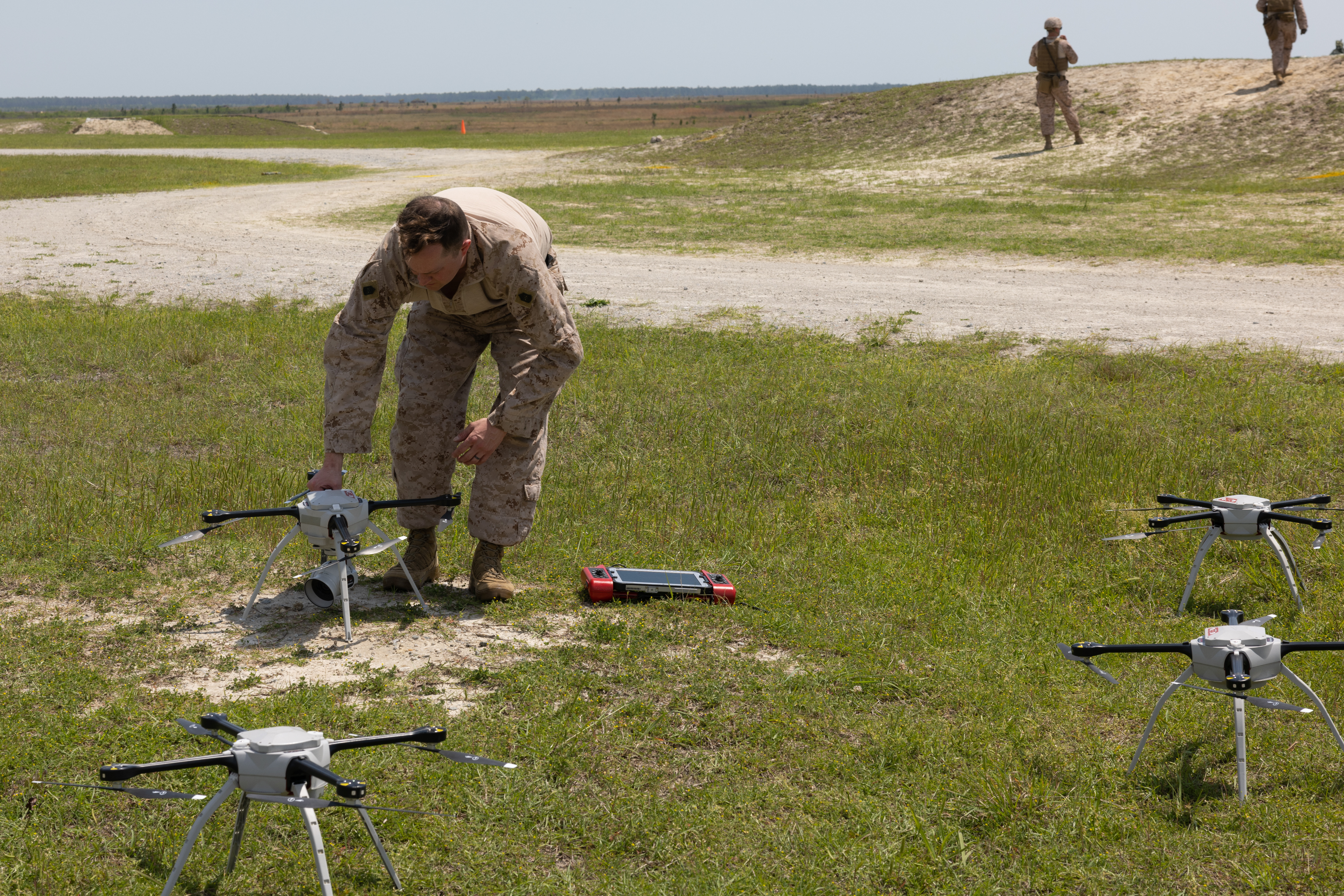
Camp Lejeune, North Carolina. (May 9, 2024): As the war in Ukraine has vividly demonstrated, drone warfare will dominate the battlefields of the future and America needs to be ready. In this photo by Lance Corporal Anakin Smith, Master Sergeant Todd Grindstaff, a weapons and tactics training chief with Headquarters and Service Battery, 2nd Low Altitude Air Defense Battalion, prepares drones for launch at a counter-unmanned aircraft firing range. The 2nd LAAD Battalion provides low altitude surface-to-air defense to a Marine Ground Task Force including the latest in counter drone technology.
On the range, Marines had to shoot, maneuver, and coordinate fires while countering multiple drone attacks simultaneously. Using advanced radar, the Marines can detect incoming drone aircraft and disrupt or destroy the threat. Under a unified command and control system, units can connect shooters with targets at combat speed under the most extreme conditions.
Some of the tools used to defeat these drones include kinetic (munitions), jamming the drone’s Global Navigation Satellite System signals, or sending blasts of microwave radiation to knock them from the skies.
- Details
- Hits: 1017
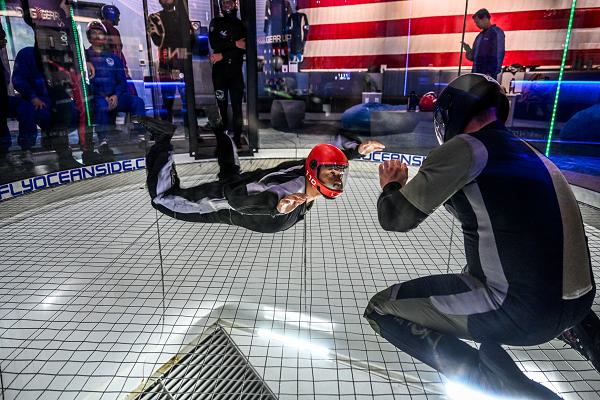
Oceanside, California. (May 6, 2024): For civilians, wind tunnels are an exhilarating thrill. For Special Forces personnel, they are a vital training tool to prepare for dangerous free fall operations into enemy territory. In this photo by Lieutenant Junior Grade Rae Timberlake, Sailors assigned to West-coast explosive ordnance disposal (EOD) units practice body control techniques during free fall training in a wind tunnel.
Using these devices has several advantages over jumping from an actual airplane. First, wind tunnels are safer. Free fall conditions are simulated in a controlled environment and participants are carefully monitored by an experienced jumpmaster. What is more, vertical wind tunnel training increases a jumper’s survivability by simulating malfunctions and in-air emergencies that could occur.
Another advantage is that participants can practice a series of body positions, corrective actions, and emergency procedures in a controlled manner. These multiple “jumps” are recorded and reviewed afterward with instructors. The tunnel generates 1600 horsepower using four fans to create a cushion of air on which participants safely float. This cushion gives the realistic experience of falling through the air at 125 miles per hour. Jumpers work on staying stable, making 360 degree turns, and sliding back and forth in the air. Once these basic movements are mastered, jumpers concentrate on managing the in-air emergencies they may encounter, including helping fellow sky divers in trouble.
Read more: Entertainment For Some, Deadly Serious for Others
- Details
- Hits: 1056
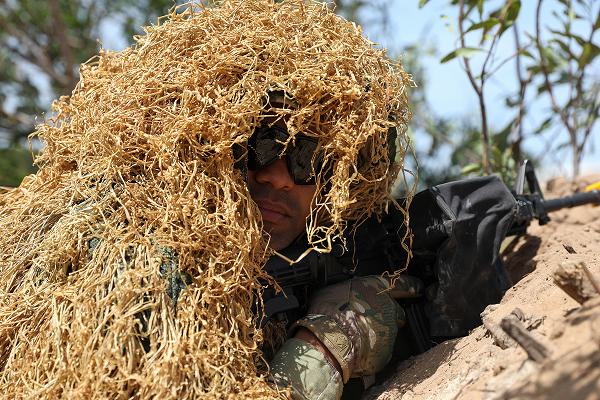
Bizerte, Tunisia. (May 7, 2024): In this photo by Specialist Shawn Fogleman, U.S. Army Sergeant 1st Class Jose Rowe Barrera prepares to spring an ambush with the Tunisian armed forces during African Lion exercises underway in this small African country. SFC Barrera is with the 1st Battalion, 175th Infantry Regiment of the Maryland National Guard. This year’s African Lion exercises included more than 8,000 participants from twenty-seven nations and NATO.
In its 20th year, the African Lion series is the U.S. Africa Command’s premiere joint exercise led by the Army Southern European Task Force. In addition to Tunisia, troops from Morocco, Ghana, and Senegal contributed forces to this year’s event which is designed to increase cooperation among America’s African allies.
The Tunisian Armed Forces consists of more than 150,000 active-duty personnel and another 12,000 in the national guard. Tunisia has contributed military forces to United Nations peacekeeping missions for years, including an army company to the United Nations Assistance Mission for Rwanda.
The U.S. Africa Command, based at Kelley Barracks, Germany, maintains military relations with 53 African nations. The Southern European Task Force is sponsoring this year’s exercises which will continue until May 31.
- Details
- Hits: 2325
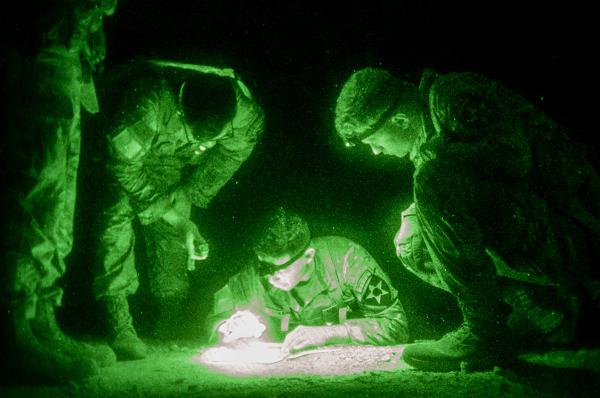
Camp Casey, South Korea. (April 30, 2024): Despite all the recent advances in GPS, Soldiers still need to know how to move people and equipment using a 16th century technology known as “dead reckoning.” In this photo by South Korean Army Corporal Mingyu Ju, Soldiers participating in a Best Squad Competition plan their route to move troops and tanks in total darkness.
Finding your way in the dark, or night land navigation, relies on techniques first used by Sailors in tall ships in the 1600s who plied the oceans before the discovery of America. “Dead Reckoning” uses calculations of one’s location based on the speed and direction from a known position. For today’s Soldiers, this means accurately plotting a course from their current position to their desired destination without the help of satellites.
The process begins with planning the route you wish to take given the terrain and distance involved. Troops use a standard military compass to “shoot an azimuth” or direction toward their objective expressed as degrees (example: 180 degrees). The route is then plotted on a 1:50 map (one inch represents 50,000 feet on the map) using a good old fashion number two pencil and a protractor. Exceptional care must be taken at this point as mistakes in calculations at the beginning are magnified over distance. If you are off by as little as half a percentage point at the start of the journey, you will find yourself way off course after travelling long distances.
- Details
- Hits: 2532
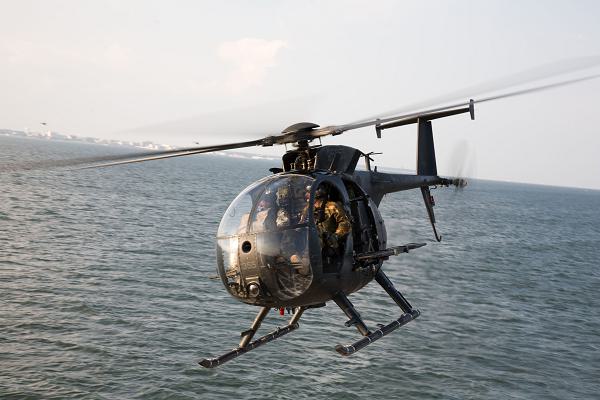
Undisclosed Location. (May 10, 2024): They are an aviation unit so elite it can promise to deliver special operations forces anywhere in the world within 30 seconds of the desired time, day, or night, and in all weather conditions. In the above unclassified photo, a member of the 160th Special Operations Aviation Regiment (SOAR) pilots a MH-6 Little Bird helicopter while training for America’s most secretive and dangerous missions.
Formed from Soldiers of the 101st Airborne Division at Fort Campbell, Kentucky in 1981, the 160th SOAR is known as the "Night Stalkers" for their skills flying with night-vision equipment and infrared devices to navigate through enemy territory. Their specialty is combat insertions and extractions of special operators in missions most aviation units would not even attempt. The Night Stalkers famously transported SEAL team members into Pakistan to capture or kill Osama bin Laden. Flying “nap-of-the-earth” over hilly terrain in total darkness, the Night Stalkers delivered and recovered the SEALS and transported them, along with Bin Laden’s body, undetected back to Afghanistan.


